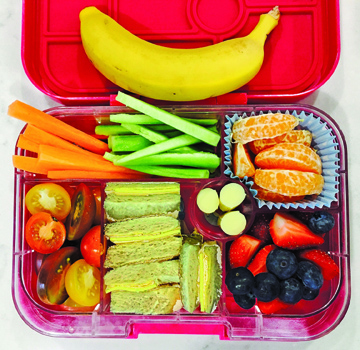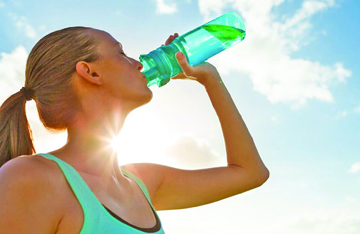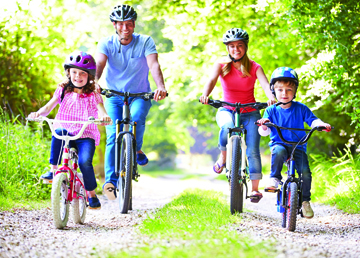
by Glendale Sports Center | Aug 23, 2019 | Feature Story Middle Left
by Cami Woomer
Childhood obesity in the U.S. affects nearly 13.7 million
children and adolescents nationwide — that’s about 1 out of every 5 kids,
according to the Centers for Disease Control and Prevention. In recognition of
National Childhood Obesity Awareness Month in September, we’re sharing
information about obesity and seven ways we can all help kids and improve their
health. Childhood obesity is a growing epidemic, and it’s imperative we give
kids the support they need to be healthy and thrive.
First, Why Is Obesity Bad For Everyone — But Especially
Kids?
Carrying excess weight at any age can have grave
implications. But for children, the implications can be emotional as well as
physical. Children with obesity are more likely to be bullied and teased, and
suffer from mental health issues, social isolation and low self-esteem.
Physically, obesity in children can lead to type 2 diabetes,
heart disease, high blood pressure, high cholesterol, sleep apnea, and asthma.
There also might be subtle indicators that a child’s weight
may be impacting other aspects of their health:
• Poor
physical endurance or ability to keep up with friends
• Shortness
of breath with exertion
• Snoring or
long pauses in breathing while sleeping
• Consistent
complaints of pain in their knees, ankles or hips
• Swelling or
fluid accumulation in their lower legs or feet
Adding to these issues, children with obesity are more
likely to struggle with obesity as adults, contributing further to risk factors
for heart disease, diabetes, and cancer.
What Causes Obesity?
There are many risk factors that can lead to obesity. Some
involve family genetics or hormonal imbalances, or even genetic disorders.
There are also many risk factors that are environmental, such as diet,
lifestyle, and physical activity. Imbalances in any of these can result in
excess weight and obesity.
Income, as a social determinant of health, can also play a
role. The CDC reports that the prevalence of obesity is almost 10% higher in
children from low-income families versus high-income families.
Despite these many risk factors, in its simplest terms,
obesity is caused by eating too many calories, eating too much of the wrong
types of calories, and exercising too little. Understanding this, there are
things we can all do to take action to fight childhood obesity and help kids
reach their full potential.
1. Start with
the drinks. This is where kids tend to consume excess calories without even
realizing it. Work with your child to decrease the number of high-sugar drinks,
including soda and juice, to one per day.
2. Teach your
child about lifestyle choices. This includes eating appropriate portion sizes,
seeking out balanced meals, and increasing physical activity. It helps to set a
good example — kids are watching and will mirror how you prepare food and eat.
3. Involve
children in meal planning, letting them choose from a variety of healthy meals.
Then take them to the store with you. Have them be part of the shopping, preparing,
and cooking process so they feel empowered.
4. Make healthy
eating and being active a family goal where everyone participates and takes an
active interest. Make good choices together, and after dinners, take a family
walk or play outside.
5. Start
healthy eating habits as soon as you can, as early as ages one to five. This is
when children are starting to eat solid foods and are developing their palates.
6. Cut down on
electronics use, including TV, cell phones, computers, and gaming consoles each
day. Or offer “trades” with your kids — perhaps one walk with the family pet
earns them one hour of screen time.
7. Encourage
eating meals and snacks at the dinner table as often as possible. This makes
meals a family event and discourages binging or mindless snacking on their own.
Cami is a nutritionist, DTR (Dietary Technician,
Registered), and a Certified Health and Wellness Lifestyle Coach. She is
involved in many YMCA programs, including Diabetes Prevention, Healthy Weight
and Your Child, and Blood Pressure Self-Monitoring. Her passion is showing
others how healthy habits are achievable and one of the greatest ways to feel
your best.

by Glendale Sports Center | Jul 26, 2019 | Feature Story Middle Left
by Liz Bravman, RN
The new school year is fast approaching. And with the new
classes comes a whole new season of packing lunches and making sure kids are
fueled for success. You may find yourself facing the same challenges year after
year: How can you avoid packing the same items every day, while giving kids
good nutritious choices. These tips can help.
1. Think in
categories of needed nutrients. It’s common to get stuck on the go-to tradition
of sandwiches. Instead, think “outside the loaf” and focus on packing one item
from each of the four nutrient categories — Protein, whole grains, fruits and
vegetables. (Note, fruits and vegetables are each their own category.)
These are examples:
Protein
• Eggs (hard
boiled or scrambled to be put into a burrito)
• Nuts
(almonds or cashews)
• Seeds
(sunflower or chia)
• Nut butters
(such as no sugar-added peanut butter or almond butter)
• Beans
• Dairy
(cheese sticks, cream cheese or shredded cheese)
• Hummus
• Edamame
• Low-sugar
Greek yogurt
• Rotisserie
chicken meat
Whole Grains
• Whole wheat
bread or small bagel
• Whole wheat
crackers
• Whole wheat
pretzels
• Brown rice
• Whole wheat
pasta
• Rice cakes
• Corn or
whole wheat tortillas
• Low-sugar
whole grain cereal or granola
Fruits
• Apples
• Bananas
• Berries
• Clementine
oranges
• Grapes
• Pineapple
• Frozen
mango chunks
Vegetables
• Cucumber
slices (try different seasonings on top)
• Carrot
sticks
• Red pepper
sticks
• Mini
peppers
• Salsa
• Sugar snap
peas
2. Tie it all
together. Next, what does it look like when these four nutrient groups come
together? Here are some lunch ideas that go beyond bread and sandwich meat:
• Whole wheat
bagel with cream cheese and cucumber slices, and a handful of strawberries and
cashews
• Celery with
no sugar-added peanut butter with raisins on top (also known as “ants on a
log”), apple slices, pretzels, and a cheese stick
• Low-sugar
Greek yogurt, plain cheerios, banana, and a few mini peppers
• Hard-boiled
eggs, rice cakes, cheese sticks, blueberries, and sugar snap peas
• Hummus with
carrot sticks and cherry tomatoes, whole wheat crackers, and cheese stick
• Cold
quesadilla with salsa and a small scoop of guacamole, cucumbers and frozen mango
chunks
• Chicken
noodle soup in a thermos, radishes, and a pear with a slice of cheese
• Whole wheat
pasta, edamame, carrots and an apple
3. Remember the
drink. Another area that can be tempting for kids is unhealthy drinks. Remember
that juice boxes can have tons of added sugars. Water, seltzer or plain milk
(or alternative dairy drink) are better options.
4. Get the kids
involved. Research shows that when children help and are invested in their food
choices, whether it is through shopping, gardening, prepping or cooking, they
are more likely to eat healthy foods. When shopping, let them pick out a new
and interesting fruit or vegetable to try in their lunch. Or start a garden at
home, even if it’s just a container garden or window sill herb garden. You may
be shocked at what your children will start loving.
5. Prepare for
new choices. Finally, know that packing a nutritious meal every day can be a
lot of work, but it can be just as challenging once your child outgrows sack
lunches and has the ability to eat at school restaurants or go off-campus with
friends. If this is common in your family, you can still help your child make
good choices.
Empower your teen to look at online menus. Show them how
many calories and fat grams certain items have. Explain what grams of sugar
look like in real life — every 4 grams equal 1 teaspoon of sugar. A large
fountain Coke has 80 grams of sugar, which equals 12 teaspoons of sugar. Let
them know that the recommended quantity for kids under 18 is 6 teaspoons daily.
This means that this one drink is double what their sugar intake should be for
the entire day!
A former pediatric nurse, Liz Bravman, RN, is a cycling
instructor, nutrition educator and personal trainer at the Susan M. Duncan
Family YMCA in Arvada. She has a Bachelor of Science degree in nursing and a
Master’s degree in nutrition education.

by Glendale Sports Center | Jun 21, 2019 | Feature Story Middle Left
by Parker Grissom
School is out and summer is here! The warm weather makes us
all want to get outside, and when we do it’s important to stay safe. These tips
can help!
Stay Hydrated
We can’t say it enough: The rule of summer is to hydrate.
But it’s not always the best bet to aim for eight 8-ounce glasses a day.
Runner’s World reports that recommended amounts are actually 91 ounces a day
for women and 120 ounces for men. That said, people vary in their activity levels
and “sweat rates,” so it is pretty safe to let thirst be your guide.
The following are other important things to know about
hydrating.
Sometimes water isn’t enough. Water is necessary for every
metabolic process of the body, as it transports nutrients and removes waste.
However, if you go for a long run or are out in the heat all day, you may need
a drink with enhanced electrolytes that can prevent your body from losing
sodium.
Water won’t keep you cool. Speaking of heat, it’s also
important to recognize that hydration alone cannot ward off the risk of heat
stroke. While dehydration can make you more prone to it, factors like exercise
intensity, humidity and air temperature can all contribute.
Don’t drink too much. Finally, while it is rare, it is possible
to drink too much, which can result in a condition called hyponatremia. When
this happens, the increased fluid intake combines with increased sweating,
causing sodium levels in the blood to become dangerously low. To prevent this,
again it’s best to let thirst be your guide and don’t overdo it.
Get The Right Gear
As you set out for Colorado’s playground, another tip to
keep in mind is equipment and clothing. In addition to outfitting yourself for
your favorite outdoor pastime, whether it is hiking, biking, running, or
camping, you also have to factor in the season’s challenges surrounding
altitude, wildlife and quick weather changes.
The best bet here is to get quality advice you trust. Do
your research and talk to others who know the ropes. This is especially
important when it comes to evaluating “trends” in fitness such as barefoot
running. Some experts say that exercising without shoes makes it possible to
absorb negative electrons from the earth through the soles of the feet, which
can be an antioxidant and have an anti-inflammatory impact on the body. It also
can improve foot position, balance and body awareness.
At the same time, other experts caution that barefoot
walking and exercising can come with increased risk. Lack of strength in the
foot can reveal poor walking mechanics, which can lead to injury. Barefoot
exercisers are also susceptible to injury from rough or wet terrain, cold
temperatures and sharp objects on the ground.
Bottom line: It’s important to seek wise advice and use your
best judgment. Know what’s a trend in fitness and what makes sense for your
lifestyle.
Remember The Sunscreen
A final way to stay safe — and another reason to use your
best judgment — is in regard to sunscreen. Recent reports have made us
second-guess ourselves and wonder whether all the sun protection could be doing
more harm than good. Harvard Medical School addresses some common
misperceptions: Does sunscreen cause skin cancer? (It doesn’t!) Does sunscreen
prevent the three main types of skin cancer? (It does!). And is sunscreen
actually poisonous to people? (It isn’t!)
The reality is that Colorado has more than 300 days of
sunshine a year, and reports show risk of skin cancer goes up with altitude, so
sunscreen is essential. Harvard Medical School also recommends avoiding sun
exposure when possible, wearing sun-protective clothing, and reapplying
sunscreen every two hours.
Parker’s purpose on earth is to make every person he meets
happier and healthier. With a degree in Exercise Science from University of
North Carolina at Wilmington, Parker achieves this purpose through group
fitness, personal training, and motivational speaking.

by Glendale Sports Center | May 25, 2019 | Feature Story Middle Left
by Nicholas Auger
Cycling is by far one of the best non-impact exercises
around, and some of the most important aspects of cycling are in the details.
Understanding them can help you turn biking from a childhood hobby into a key
element of a healthy and active lifestyle. Here are four tips to get you
started down the road.
ABC Bicycle Check
Before you get on any bicycle, run over the basic components
of the bike and confirm they are working. The “ABC Check” is a universal
approach.
A is for Air. Check that both wheels are inflated to a firm
squeeze. If they’re low, check the side of the tire for the inflation number
labeled as PSI, which will typically be 45 to 65 and can go up to 160.
B is for Brakes. Inspect the braking mechanism. It could be
a hand lever on the handle bars or a coaster brake. Engage the brakes and try
to move to see if the tires roll. They should not!
Lastly, C is for Chain. Pedal the cranks backward (or
forward if you have coaster brakes) and check that the chain is intact and
moves easily.
Manage Comfort
Make sure you’re comfortable on the bike! Bicycles have
specific sizes and can be modified to fit many different riders. When you are
on the bicycle, the seat should be high enough for your leg to almost fully
extend. And typically, if on the saddle, you should be on your tippy toes to
reach the ground. This will help you use your leg muscles in a more efficient
way.
Adjust the handlebars, grips, and levers. A bicycle mechanic
can help you make additional modifications. Cycling shorts with pads and
thicker seats, as well as gloves and glasses, can provide quick improvements.
Lastly, safety: Invest in a helmet that is less than eight years old and make
sure it is comfortable.
Balance Your Body/Mind Connection
When you start a cycling routine, it’s common to overdo it
at first, or to get quickly discouraged after a few hills. Cycling calls for
strength to power major muscle groups, and cardiovascular endurance — both can
leave you out of breath when you’re first starting out. This is where
understanding the importance of breathing and a few breathing exercises can
improve your performance before you get on the bike.
The first is Alternative Nostril Breathing or Anuloma
Viloma. As a yoga movement, the exercise is designed to calm and stabilize your
mind and body and balance the right and left side of the brain, which makes
pedaling more even.
To do the exercise, take these steps:
• Begin in a
comfortable, seated position in a chair or the floor with pillows.
• With one
hand, make the “hang loose” sign with your pinky and thumb extended.
• Take in a
full inhale through your nose.
• Using your
thumb on the “hang loose” hand, close your right nostril and fully exhale out
of your left nostril.
• Once the
exhale is complete, keep your thumb in the same place and take a full inhale
through your left nostril.
• Once the
inhale is complete, use your pinky on that same hand to close the left nostril,
keeping your thumb closing the right nostril. Hold your breath in with both
nostrils closed.
• On the next
inhale, remove your thumb and exhale fully out of the right nostril.
• Now inhale
fully with your pinky closing the left side nostril.
Another exercise is known as the One-Minute Breath. Also
performed off the bike, the exercise involves taking the least amount of
breaths you can for one minute. First, sit comfortably and slow your breathing,
focusing on all parts of the breath. Progressively lengthen the timing of each
inhale and exhale, pausing and retaining your breath every time you breathe in
and out.
Ride To The Rhythm …
Of Your Breath
Once on the bike, practicing breath cadence can keep you
going the distance. To do this, count your breaths to the rhythm of your crank
revolutions. For example, one inhale may last as long as four crank
revolutions. Focusing on the pace of your breathing and your physical exertion
syncs your breathing with your body, which helps regulate oxygen flow, control
your heart rate, and boost your endurance.
Through cycling, you can improve strength and your overall
health and push your fitness to new levels. Besides it’s just plain fun. Pedal
on!
Nicholas found fitness through his BFA in sculpture. Now,
instead of metal and wood, he focuses on enriching communities through creating
programs that sculpt spirit, mind and body. Ten years of teaching yoga, kids
yoga, group exercise, and personal fitness training has led him to the role of
Health and Wellness Director at the Downtown Denver YMCA.

by Glendale Sports Center | Dec 17, 2018 | Feature Story Middle Left
by Alison Chism
A popular New Year’s resolution for many people is to eat
healthier, begin exercising and lose weight. Yet, a common question is how to
kick-start an exercise program that provides the most benefit? This leads us to
what are fast fat burners and how can you get the most results from your
workout? Here are three strategies to keep in mind as you start the New Year.
Begin Strength Training
Everyone has probably heard how great strength training is
for your body. But you might not realize how critical it is for burning fat.
Calories are the fuel that creates energy, which keeps our
bodies going throughout the day. These calories must be burned, or they will be
stored as fat. When you strength train, you “break down” muscles in order to
build them back up stronger. In doing this, our muscles need to consume a lot
of calories. And, the more we break down our muscles and force them to repair
themselves, the more calories we burn. In addition, the more muscle we have,
the more calories will be burned to fuel them.
For example, consider two individuals who each weigh 150
pounds. One has a body fat percentage of 40%, making their remaining 60% lean
body mass of muscle and water weight. The other individual has a body fat
percentage of 25%, making their remaining 75% lean body mass. What does this
mean? The individual who has a higher percentage of lean body mass will burn
more calories to fuel their muscles rather than storing the calories as fat.
Additionally, because our muscles need so much fuel,
strength training makes our bodies continue to burn more calories even after
working out, up to 39 hours!
Consume Enough Protein
Protein is the main macronutrient that feeds our muscles and
bodies to keep them strong. As stated, having a stronger body with more muscle
will organically burn more calories than having less muscle. Therefore, we need
to ensure we are consuming enough protein to help keep our bodies strong.
Protein can also help increase or regulate metabolism. This
is because our bodies burn calories when we are digesting food. This is called
the thermic effect of food. It is estimated that 20% to 35% of calories are
burned during digestion when we eat protein-rich food. When we eat fat and
carbohydrates, we only burn 5% to 15%.
Sleep, Sleep, Sleep
…And More Sleep
Finally, getting enough sleep every night is arguably the
most important component to living healthy and burning fat. Think of when your
computer shuts down and reboots. It requires a certain amount of time to be
completed or else the programs do not run successfully or efficiently. Our
bodies are the same way. When we go to sleep at night, our bodies are shutting
down in order to reboot for the next day. If we do not give our bodies enough
time, then our bodily functions get messed up and do not run properly. These
functions can include our metabolism, hormones, ability to deal with stress,
and brain function.
Getting active and raising your heart rate is always good
for you, and committing to an exercise program is a great way to start a New
Year. By adding fat burners to your routine, you can make sure your workout is
working as hard as you are.
Alison Chism is the Health & Wellness Director at the
YMCA Glendale Sports Center at Infinity Park. She is certified as an ACSM
Personal Trainer, ACE Health Coach and TRX Suspension Trainer. She is also
certified in ACSM Exercise is Medicine. She has a Bachelor of Science degree in
Health Promotion and is pursuing a Master’s Degree in Health and Wellness
Management.






